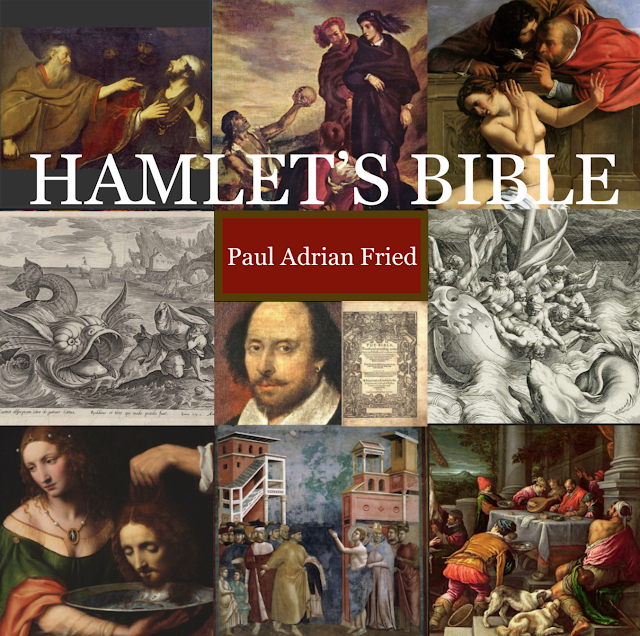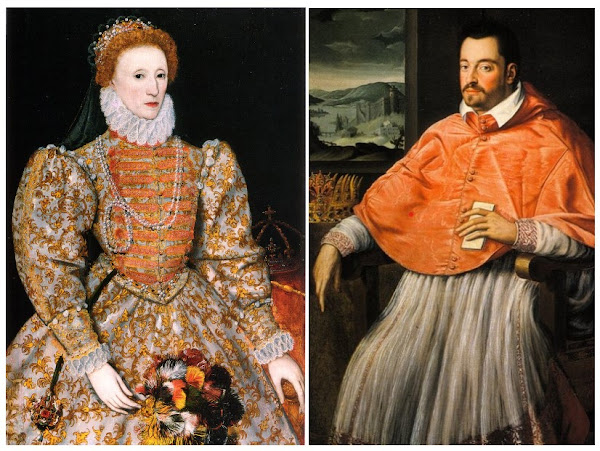Elizabeth I, Popes, & Ferdinando I de' Medici in Love's Labor's Lost
Love’s Labor’s Lost was Christmas entertainment (1593) for Elizabeth I and her court. It's about a bunch of guys who try to be celibate, and who keep a princess and her attending ladies locked out of their castle. The men fall in love with the women, but the women get the last word.
Sort of like popes (some who failed at the celibacy thing) who excommunicated Elizabeth, keeping her out of the “castle” of the Roman Church, but never getting what they desired of her.
Many scholars note that the character of King Ferdinand is based on King Henry III of Navarre, who had been raised Protestant, and who Elizabeth I had supported in French wars of religion. He converted to Catholicism (“Paris is worth a mass”) to consolidate his power as the next king of France, disappointing Elizabeth.
Of the nine popes during Elizabeth’s reign,* one of them, Gregory XIII (1572-85), had a child out of wedlock (like Armado and Jaquenetta in the play) before his ordination.
In their oaths and the details of their arrangements to avoid the company of women, Ferdinand proposes that any woman who comes within a mile of the court will have her tongue cut out. (This may remind some of the fate of Lavinia in Titus Andronicus who is raped and has her hands cut off and her tongue cut out.) Pope Sixtus (1585-90) was an even more violent authoritarian, deciding that priests and nuns who broke their vows of celibacy would be executed. In 1586, he tried to pass the death penalty for adultery in Rome, as in Lev 20:10 & Deut 22:22–25. (This may remind readers of Angelo in Measure for Measure, who tries to impose similar death penalties for adultery while briefly ruling in the absence of Duke Vincentio.)
The severity of King Ferdinand's penalties echoes more the lack of mercy in the papacy than it does Henry III of Navarre.
Pius IV (1559-65) had once been rebuked by a cardinal for proposing to make his 13-year-old nephew a cardinal. The man who’d rebuked him later became Pope Pius V (1566-72), so strict in his penalties for adultery and sodomy that people complained he was trying to turn Rome into a monastery. This, in contrast with the nephew, Ferdinando I de' Medici who, during his years as cardinal (1562-89), showed toleration toward Jews and heretics. In England, Catholics and Puritans had hoped Elizabeth might show more religious toleration.
King Ferdinand abandoned his oath to propose marriage to the princess; Ferdinando I de’ Medici gave up his cardinal position to be married. Perhaps this explains why the play’s king is Ferdinand instead of Henry?
[L: Elizabeth I, "The "Darnley Portrait," circa 1575. Public domain, via Wikipedia. R: Ferdinando I de' Medici as Cardinal (1562 to 1589). Florentine artist in the periphery of Alessandro Allori, 1588 - Polo Museale Fiorentino. Public domain via Wikipedia.]
In a 2011 book called Visions of Venice in Shakespeare (eds. Laura Tosi, Shaul Bassi), chapter five is by Gilberto Sacerdoti: “'Self-sovereignty' and Religion in Love's Labour's Lost: From London to Venice via Navarre.” Sacerdoti explains the play’s connections to Navarre, and why a reference to deer hunting by the princess seems to relate to Elizabeth’s sovereignty: The 3-year-old deer, with three points on each antler, signifies 33, the approximate age of Jesus at his death, commemorated in the mass.
Elizabeth doesn’t need a pope’s mass to approve her authority. At play’s end, the princess has the upper hand. Deer hunting may also relate to Elizabeth creating martyrs by executing Catholics (by analogy, hunting deer)....
~~~~~~~~~~~~~~~~~~~~~~~~
* The nine popes during the reign of Elizabeth I:
Pope Paul IV, 1555-1559
Pope Pius IV, 1559-1565
Pope Pius V, 1566-1572
Pope Gregory XIII, 1572-1585
Pope Sixtus V, 1585-1590
Pope Urban VII, 1990
Pope Gregory XIV, 1590-1591
Pope Innocent IX, 1591
Pope Clement VIII, 1592-1605
~~~~~~~~~~~~~~~~~~~~~~~~
Notes / Works Consulted in writing this blog post:
1. It occurred to me that the women in LLL being locked out of the castle resembled Elizabeth being excommunicated by at least two popes, while others upheld the excommunications.
So I looked into the names and basic histories of the nine popes during her reign - via (of course) Wikipedia.
2. Some of the Wikipedia pope articles mentioned a number of popes who proposed severe penalties (even death) for clergy and religious breaking vows of chastity - perhaps because Protestants often portrayed them as breaking those vows - and also popes proposing severe penalties for adultery and sodomy. This sounded similar to the severity of cutting out tongues of women who come within a mile of the palace (which also sounds like another Shakespeare play, and Greek sources, of women raped and their tongues cut out).
3. One Wikipedia article mentioned the future Pope Sixtus V disagreeing with a sitting pope about making his 13-year-old nephew a cardinal. I wondered: Who might that be?
4. Another google search or two revealed that it was Ferdinando I de' Medici (via Wikipedia).
5. Chicago Shakespeare Theater had a great resource for teachers about the play:
https://d20szssgzbrkwr.cloudfront.net/res/education/Teacher%20Workshop%20handouts/CST_EDU_LLLTeacherHandbook_2017Edit_Rev(1).pdf
6. Many resources mentioned King Henry III of Navarre being the basis of King Ferdinando of Navarre in the play.
7. A search for King Henry III of Navarre and LLL on Google Scholar led to a book about Shakespeare and Venice:
https://www.routledge.com/Visions-of-Venice-in-Shakespeare/Tosi-Bassi/p/book/9781315547992
Long excerpts were available on Google Books:
https://books.google.com/books?hl=en&lr=&id=iSirCwAAQBAJ&oi=fnd&pg=PA83&dq=love%27s+labour%27s+lost+elizabeth+excommunicate&ots=cjfDVZGTVg&sig=KF-JvWmZQNrfi5JHA3naDOaT2Us#v=onepage&q=love's%20labour's%20lost%20elizabeth%20excommunicate&f=false
8. The book mentioned deer hunting as related to the death of Jesus and the Catholic Mass, but it also seemed to me that a princess hunting deer could point to Elizabeth executing Catholics and making martyrs.
9. Found in the book, Mythology and Diplomacy in the Age of Exploration, by Adam Knobler (BRILL, Nov 28, 2016):
"Ferdinando [I de' Medici] was an interesting figure: he enacted an edict of tolerance in the late sixteenth century inviting Jews and heretics to settle in Florentine lands and the city of Livorno became a center for Jewish refugees from Spain. He also established the Typographia Medicea, in order to publish books in Arabic."
- Some readers may know of the story told by Richard E Rubenstein in his book, Aristotle's Children: How Christians, Muslims, and Jews Rediscovered Ancient Wisdom and Illuminated the Dark Ages (Harcourt, 2003): Translating newly rediscovered ancient works with the help of Jews and Muslims had earlier proven to be an important inspiration for new learning.
Many college and high school teachers - if they knew of all the Wikipedia sources - might not accept an assignment based on so much Wikipedia. If I were to seek publication in a journal, I'd have to dig for better sources, but Wikipedia can be a useful starting point.
~~~
MY RECENT POSTS ON LOVE'S LABOR'S LOST:
5. Love's Labor's Lost, Arcangela Tarabotti, and Mirrors of Difference - November 16, 2021
4. Elizabeth I, Popes, & Ferdinando I de' Medici in Love's Labor's Lost - November 9, 2021
3. Women Priests Assigning Penance in Love's Labor's Lost? - November 2, 2021
2. Good & Grace from Evil & Sin in Love's Labor's Lost & Henry V - October 24, 2021
1. Begging & Poor (& Chastity & Pregnancy) in Love's Labour's Lost (1594-1597) - October 12, 2021 (this #1 post was also part of another series)
~~~~~~~~~~~~~~~~~~~~~~~~
Thanks for reading!
My current project is a book tentatively titled Hamlet’s Bible, about biblical allusions and plot echoes in Hamlet.
Below is a link to a list of some of my top posts (“greatest hits”), including a description of my book project (last item on the list):
https://pauladrianfried.blogspot.com/2019/12/top-20-hamlet-bible-posts.html
I post every week, so please visit as often as you like and consider subscribing.


Comments
Post a Comment